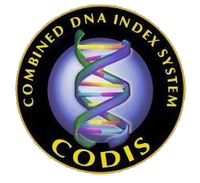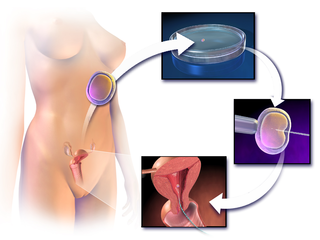
DNA profiling is the process of determining an individual's deoxyribonucleic acid (DNA) characteristics. DNA analysis intended to identify a species, rather than an individual, is called DNA barcoding.

Forensic science, also known as criminalistics, is the application of science principles and methods to support legal decision-making in matters of criminal and civil law.
DNA paternity testing is the use of DNA profiles to determine whether an individual is the biological parent of another individual. Paternity testing can be especially important when the rights and duties of the father are in issue and a child's paternity is in doubt. Tests can also determine the likelihood of someone being a biological grandparent. Though genetic testing is the most reliable standard, older methods also exist, including ABO blood group typing, analysis of various other proteins and enzymes, or using human leukocyte antigen antigens. The current techniques for paternity testing are using polymerase chain reaction (PCR) and restriction fragment length polymorphism (RFLP). Paternity testing can now also be performed while the woman is still pregnant from a blood draw.

Genetic testing, also known as DNA testing, is used to identify changes in DNA sequence or chromosome structure. Genetic testing can also include measuring the results of genetic changes, such as RNA analysis as an output of gene expression, or through biochemical analysis to measure specific protein output. In a medical setting, genetic testing can be used to diagnose or rule out suspected genetic disorders, predict risks for specific conditions, or gain information that can be used to customize medical treatments based on an individual's genetic makeup. Genetic testing can also be used to determine biological relatives, such as a child's biological parentage through DNA paternity testing, or be used to broadly predict an individual's ancestry. Genetic testing of plants and animals can be used for similar reasons as in humans, to gain information used for selective breeding, or for efforts to boost genetic diversity in endangered populations.
Genetic genealogy is the use of genealogical DNA tests, i.e., DNA profiling and DNA testing, in combination with traditional genealogical methods, to infer genetic relationships between individuals. This application of genetics came to be used by family historians in the 21st century, as DNA tests became affordable. The tests have been promoted by amateur groups, such as surname study groups or regional genealogical groups, as well as research projects such as the Genographic Project.
Forensic identification is the application of forensic science, or "forensics", and technology to identify specific objects from the trace evidence they leave, often at a crime scene or the scene of an accident. Forensic means "for the courts".
The United Kingdom National DNA Database is a national DNA Database that was set up in 1995. In 2005 it had 3.1 million profiles and in 2020 it had 6.6 million profiles. 270,000 samples were added to the database in 2019–20, populated by samples recovered from crime scenes and taken from police suspects. 124,000 were deleted for those not charged or not found guilty. There were 731,000 matches of unsolved crimes between 2001 and 2020.
Genetic discrimination occurs when people treat others differently because they have or are perceived to have a gene mutation(s) that causes or increases the risk of an inherited disorder. It may also refer to any and all discrimination based on the genotype of a person rather than their individual merits, including that related to race, although the latter would be more appropriately included under racial discrimination. Some legal scholars have argued for a more precise and broader definition of genetic discrimination: "Genetic discrimination should be defined as when an individual is subjected to negative treatment, not as a result of the individual's physical manifestation of disease or disability, but solely because of the individual's genetic composition." Genetic Discrimination is considered to have its foundations in genetic determinism and genetic essentialism, and is based on the concept of genism, i.e. distinctive human characteristics and capacities are determined by genes.
A DNA database or DNA databank is a database of DNA profiles which can be used in the analysis of genetic diseases, genetic fingerprinting for criminology, or genetic genealogy. DNA databases may be public or private, the largest ones being national DNA databases.
Personal genomics or consumer genetics is the branch of genomics concerned with the sequencing, analysis and interpretation of the genome of an individual. The genotyping stage employs different techniques, including single-nucleotide polymorphism (SNP) analysis chips, or partial or full genome sequencing. Once the genotypes are known, the individual's variations can be compared with the published literature to determine likelihood of trait expression, ancestry inference and disease risk.

The Combined DNA Index System (CODIS) is the United States national DNA database created and maintained by the Federal Bureau of Investigation. CODIS consists of three levels of information; Local DNA Index Systems (LDIS) where DNA profiles originate, State DNA Index Systems (SDIS) which allows for laboratories within states to share information, and the National DNA Index System (NDIS) which allows states to compare DNA information with one another.
Rapid DNA describes the fully automated process of developing a CODIS Core STR profile or other STR profile from a reference sample buccal swab. The “swab in – profile out” process consists of automated extraction, amplification, separation, detection and allele calling without human intervention. A machine designed to perform such rapid DNA analysis is called a DNA "magic box" by enforcement authorities.
Maryland v. King, 569 U.S. 435 (2013), was a decision of the United States Supreme Court which held that a cheek swab of an arrestee's DNA is comparable to fingerprinting and therefore, a legal police booking procedure that is reasonable under the Fourth Amendment.

DNA phenotyping is the process of predicting an organism's phenotype using only genetic information collected from genotyping or DNA sequencing. This term, also known as molecular photofitting, is primarily used to refer to the prediction of a person's physical appearance and/or biogeographic ancestry for forensic purposes.

Colorado Bureau of Investigation (CBI), a division of Colorado Department of Public Safety, is a law enforcement agency of the state of Colorado that performs forensic and laboratory services and criminal investigations at the request of local and state law enforcement agencies and district attorneys. They investigate arson, homicides, sexual assaults, fraud, cyber, identity theft, and other crimes. Their forensic services include DNA, biology, firearm, latent print, toxicology and drug chemistry analysis. Other units in the CBI include Crime Scene Services, Crime Information Management Unit, Criminal Justice Information Systems, and Colorado’s InstaCheck Unit. The CBI is designated by the Federal Bureau of Investigation (FBI), Criminal Justice Information Services (CJIS) Division, as the CJIS Systems Agency for Colorado. It is headquartered in the Denver suburb of Lakewood at 690 Kipling Street.
Genetic privacy involves the concept of personal privacy concerning the storing, repurposing, provision to third parties, and displaying of information pertaining to one's genetic information. This concept also encompasses privacy regarding the ability to identify specific individuals by their genetic sequence, and the potential to gain information on specific characteristics about that person via portions of their genetic information, such as their propensity for specific diseases or their immediate or distant ancestry.

Investigative genetic genealogy, also known as forensic genetic genealogy, is the emerging practice of utilizing genetic information from direct-to-consumer companies for identifying suspects or victims in criminal cases. As of December 2023, the use of this technology has solved a total of 651 criminal cases, including 318 individual perpetrators who were brought to light. There have also been 464 decedents identified, as well as 4 living Does. The investigative power of genetic genealogy revolves around the use of publicly accessible genealogy databases such as GEDMatch and FamilyTreeDNA. On GEDMatch, users are able to upload their genetic data from any direct-to-consumer company in an effort to identify relatives that have tested at companies other than their own.
DNA encryption is the process of hiding or perplexing genetic information by a computational method in order to improve genetic privacy in DNA sequencing processes. The human genome is complex and long, but it is very possible to interpret important, and identifying, information from smaller variabilities, rather than reading the entire genome. A whole human genome is a string of 3.2 billion base paired nucleotides, the building blocks of life, but between individuals the genetic variation differs only by 0.5%, an important 0.5% that accounts for all of human diversity, the pathology of different diseases, and ancestral story. Emerging strategies incorporate different methods, such as randomization algorithms and cryptographic approaches, to de-identify the genetic sequence from the individual, and fundamentally, isolate only the necessary information while protecting the rest of the genome from unnecessary inquiry. The priority now is to ascertain which methods are robust, and how policy should ensure the ongoing protection of genetic privacy.

GEDmatch is an online service to compare autosomal DNA data files from different testing companies. It is owned by Qiagen.

Fertility fraud is the failure on the part of a fertility doctor to obtain consent from a patient before inseminating her with his own sperm. This normally occurs in the context of people using assisted reproductive technology (ART) to address fertility issues.








